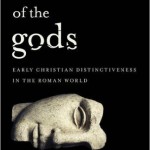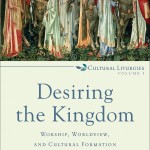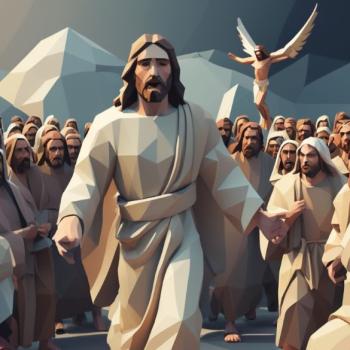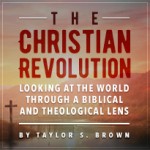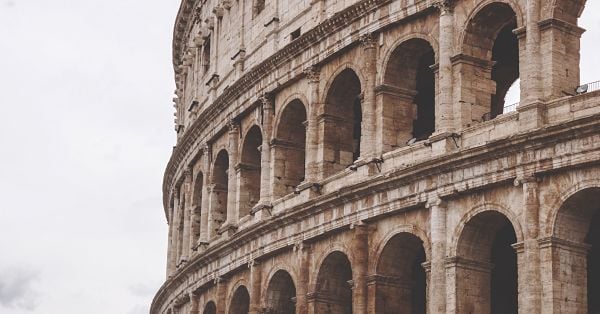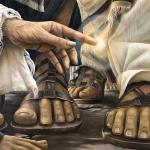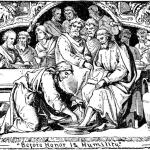I have posted a few sermons on this blog over the last several months. This is my most recent one on 1 Peter 2:2-10 from just near the end of this past academic year. It was my first time preaching from one of the catholic epistles. While most of my time in both New Testament exegesis and sermon-writing has revolved around the Gospels and the Pauline epistles, I really enjoyed wrestling with this text and crafting a sermon around it.

“Living Stones”
2 Like newborn babies, crave pure spiritual milk, so that by it you may grow up in your salvation, 3 now that you have tasted that the Lord is good.
4 As you come to him, the living Stone—rejected by humans but chosen by God and precious to him—5 you also, like living stones, are being built into a spiritual house c to be a holy priesthood, offering spiritual sacrifices acceptable to God through Jesus Christ. 6 For in Scripture it says:
“See, I lay a stone in Zion,
a chosen and precious cornerstone,
and the one who trusts in him
will never be put to shame.”
7 Now to you who believe, this stone is precious. But to those who do not believe,
“The stone the builders rejected
has become the cornerstone,”
8 and,
“A stone that causes people to stumble
and a rock that makes them fall.”
They stumble because they disobey the message—which is also what they were destined for.
9 But you are a chosen people, a royal priesthood, a holy nation, God’s special possession, that you may declare the praises of him who called you out of darkness into his wonderful light. 10 Once you were not a people, but now you are the people of God; once you had not received mercy, but now you have received mercy. (1 Peter 2:2-10 NIV)
We often need encouragement. We need it in our jobs. In our families. In our friendships. And we especially need it in our Christian life. Living as faithful witnesses for Christ in a world that does not recognize Him can often lead to suffering and adversity. It is in those times that we most need encouragement from our Christian brothers and sisters.
This was especially true for the earliest Christians. As a small community of faith spread throughout a Roman Empire that viewed them with suspicion and hostility, the earliest Christians often lived on messages of hope and encouragement. This is the context in which today’s text was written. First Peter was written as a circular letter by the Apostle Peter to several churches located in Asia Minor; modern-day Turkey. The opening of the letter indicates that these early Christian communities were experiencing suffering, almost certainly in relation to their faithful witness to Christ. And so Peter sought to bolster their faith.
Our text picks up near the end of the first main part of the letter. As a means of instilling them with hope, Peter has so far been identified the Christian Church with Israel, the people of God in the Old Testament. So far he has done this by linking them to key parts of Israel’s history: their exodus from Egypt, their journey through the wilderness, and also to their status as the covenant people of God.
Part of being this people of God meant growing in one’s salvation in the midst of suffering; indeed, even through suffering on behalf of Christ. This is why Peter uses the language of nourishing spiritual milk. Just as infants need the nutrients in milk in order to grow and develop well, so Christians need spiritual food that is fundamental for spiritual growth and endurance; especially in the midst of hostile environments.
But there is an additional reason that Peter encourages the early Christian churches toward increased growth and endurance in this letter. As Peter sees it, the churches he writes to are not simply outposts of Christ’s Kingdom in the ancient Roman world, though they are certainly that. Rather, it is because they, as the Church, are being built into the temple of God.
Peter speaks of “living stones” here. Now these aren’t simply rocks you find on the ground. They are cut stones, hewn to precise dimensions for the construction of a building. First, Peter speaks of Christ as the Living Stone. He talks about how Christ as the Living Stone was rejected by humans. In this way, Peter recalls Christ’s own unjust trial before the religious and governmental elite. The human “powers that be” rejected this Stone. But their verdict was not the last word. For Christ was chosen by God and is precious to Him. The supreme irony of this is that Christ is the preeminent foundation stone and the human powers that claim supreme authority for themselves not only failed to see this; they also had their verdict overturned by the Creator God.
This “cosmic irony” is then extended by Peter to all those who are in Christ. For when Christians come to Christ and are incorporated into His body, the Church, they begin to be formed into living stones like Him. And these “living stones”—oppressed by the world and suffering for Christ—they are the ones who are being built up by God into a “spiritual house.” This of course is the language used by Jesus himself to speak of the temple of God. Indeed, Peter may have picked it up from Christ himself. The major difference is that now the temple of God is no longer a physical locale in Jerusalem where God’s presence is centered. Instead, it is the corporate community of those faithful to Christ that is now God’s temple. If the temple is where God’s presence dwells, then it now dwells supremely in Christ and derivatively in those united to Him.
Peter reinforces this even further with his language of Christians as being a holy priesthood. In ancient Israel, priests were those special officials who had special access to God on behalf of the rest of the people. It was the priests who offered sacrifices to God, both for the atonement and for thanksgiving.
Here though, Peter reminds the early Christians that they as the Church are now all part of a holy priesthood. As the Body of Christ they have access to God through Christ. It is because Christ as the once-for-all atoning sacrifice is the Mediator between God and humanity, that those who are in Christ can offer spiritual sacrifices of praise and thanksgiving. In other words, the Church, empowered by Christ and the Holy Spirit, has the same kind of close (if not closer) access to God that the priests of ancient Israel did.
Again though, as Peter reminds them (and us), this is only possible at all because of Christ. Peter quotes the prophet Isaiah again, saying that God Himself has “laid a stone in Zion, a chosen and precious cornerstone.” This “stone in Zion” is of course Jesus. By quoting Isaiah—one of the greatest of the Hebrew prophets—Peter again gives the churches he is writing to hope and encouragement. Christ as the “Living Stone” was spoken of by the Hebrew prophets centuries ago. As such, the Church’s foundation finds its roots deep in the history of God and his people.
Peter is not only giving these churches hope, he is also giving them a history.
Before going any further we need to take a quick aside to better understand what exactly a cornerstone is. Don’t worry though, I won’t be using any technical architectural terms. Not least because I myself have almost no knowledge of architecture.
A cornerstone is the first stone that is laid when a new building is being constructed. It not only forms the base upon which the rest of the stones will be laid, it also orients how the rest of the stones will be arranged. In essence, this one stone shapes the direction and structure of the whole building. The cornerstone—especially in ancient architecture—determined how a building would be built.
When Peter speaks of Christ as a cornerstone then, he is using this kind of building imagery. Christ is not only the Mediator, He is the living cornerstone; the foundational, orienting rock upon which the Church is built. Their structure and direction—our structure and direction—is determined by Him.
Again, Peter quotes from the Old Testament, this time from the Psalms. The supreme irony of the cross and the resurrection of Christ is that the stone that the human “builders” rejected, is the stone that God Himself has made the foundational cornerstone of His people. The point of this is that the key perspective here is God’s, not humanity’s. For from humanity’s fallen vantage point, the way of the cross looks like foolishness. But from God’s perspective—from the perspective of the resurrection—it is the very foundation of His people.
One last time, Peter calls the prophet Isaiah as a witness to Christ as the cornerstone of God’s people. But this time, Peter quotes Isaiah to show how Christ the Cornerstone not only serves as the foundation of the people of God, but also as the rock upon which those hostile to God stumble. The word that Peter uses here is the same one from which our term “scandal” derives. It is that which causes someone to stumble or to take offense.
The imagery is important here. It demonstrates just how counterintuitive the Christian gospel was in the ancient world. A crucified Messiah? A king that the Romans killed? How could this be?! The early Christians were viewed not only as treasonous (for they refused to worship the emperor and the gods that upheld the empire) but also as irrational because of this gospel.
But again, the theme of supreme irony is in play here. To the larger Roman world that valued honor and power above all else, the proclamation of the Crucified Lord appeared foolish and scandalous. In reality though, the way of the Crucified Lord is the supreme rationality of God Himself.
Far from being irrational, the proclamation of Christ crucified and risen displays the very logic of God’s reality. The highest goods are not honor and power for oneself. For God the Son willingly took on flesh and, in the words of Peter’s fellow Apostle, Paul: “humbled Himself by becoming obedient to death— even death on a cross! (Phil 2:8).”
This is the Rock of Truth. The rationality of the Creator God is that of humble and self-giving love, not the self-aggrandizing grasping of power and prestige. What the ancient pagan world wrongly viewed as irrational and foolish is, in actuality, the underlying truth of all of reality. Christian faith and rationality are thus never opposed. Instead, it is certain systems of human thought that are not deeply rational enough.
And it is this firm Stone of Truth—that the Word of God, the Ordering Rationale of Creation, the crucified and risen Jesus—that is simultaneously the sure foundation of God’s people and the stumbling block for those who have hardened themselves against God.
By using this stone imagery, Peter is conveying to his churches that Christ is the firm, foundational anchor point in the midst of their trials and suffering. During the tribulations they suffer, Peter provides encouragement that is grounded in the One who defeated Death itself.
Just as Israel received hope and encouragement from prophets like Isaiah, so Peter does the same for the early churches he writes to. He does this by placing them in the same category and story as the people of Israel. Those who are faithful to Christ are “a chosen people,” “a royal priesthood,” “a holy nation,” and “God’s special possession.”
These are all names that are applied to Israel in the Old Testament. There is a key difference here though. All these designations find their root in Christ as the “living Stone” and the “chosen and precious cornerstone” mentioned earlier in the text. For Peter, the key foundation of the Church’s hope and the Church’s life is the same: Christ himself.
It is because Jesus Christ Himself is the “living Cornerstone” of God that all those who are united to Him participate in His resurrection life. In doing so, we ourselves become living stones in Christ’s image; the living building blocks of God’s people. We as the Church become the dwelling place of His presence, empowered and enlivened by the same Spirit that raised Christ from the dead. And so God builds us upon His firm cornerstone: the Crucified and Risen Christ.
This is the key to Peter’s encouragement. It is not a trite saying or half-hearted claim that things will just “get better.” Peter knows that suffering is a reality for Christians who witness to Christ’s kingship in a world of idolatrous power. Peter’s encouragement to the early Christians is not vague optimism.
Peter’s encouragement to them, and to us, is that of resurrection-shaped hope.
It is a hope in divine love that is stronger than Death itself. It is a hope that takes those who were at one time “not a people” as Peter says in v. 10, calls them into the marvelous light of Christ and makes them into “the people of God.”
Peter’s encouragement speaks through the centuries to us as Christians today. When we are experiencing suffering as a result of our faithful witness to Christ, we hear Peter’s words. We are anchored to God’s Chosen and Precious Cornerstone, Christ Himself, who upholds us in our times of trial. We are reminded of the fact that we as the Church are “living stones” built up by God upon Christ’s foundation. We are reminded that we are a royal priesthood, sharing close connection to God through Christ our Mediator.
Peter’s words speak just as powerfully today as they did to their first recipients. We take heart then in the midst of trials and suffering. For though the Cornerstone was rejected by humans, He has been chosen and raised by God. On this our hope is grounded. Amen.

